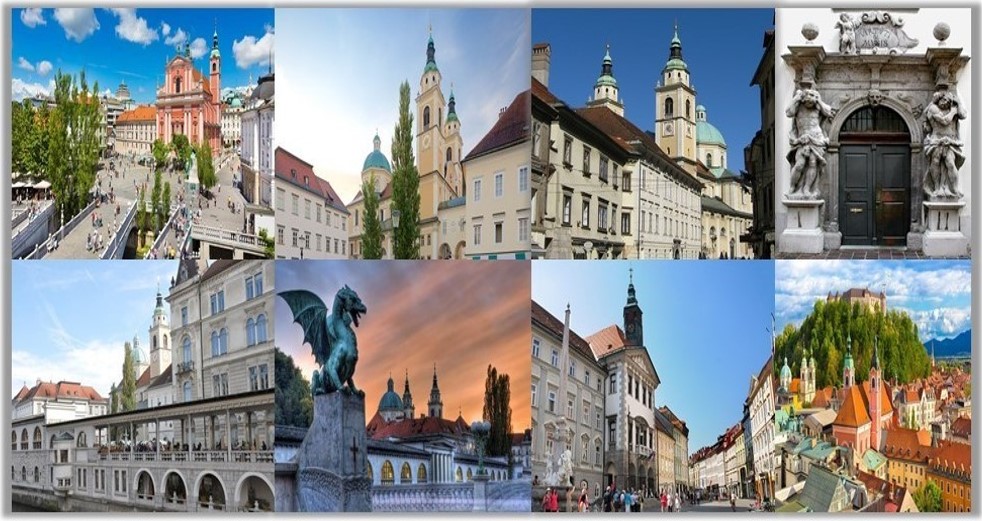Top city sights

Prešeren Square (Prešernov trg)
This square is named after the greatest Slovenian poet, France Prešeren (1800-1849). His poetry is a symbol of longing for love and freedom, which is why one of his poems became the national anthem. For the locals, Prešeren Square is the heart of the city, a meeting place where they celebrate cultural events and public holidays. The monument to Prešeren was unveiled in 1905 and is the work of architect Maks Fabiani and sculptor Ivan Zajc. The ornamented façade of the Franciscan Church, built between 1646 and 1660, dominates the square, based on the Italian model. Its great altar is the work of sculptor Francesco Robba, from 1736. Tromostovje (Triple Bridge), a special architectural feature of Ljubljana, is made up of the old stone bridge from 1842 and two more bridges which architect Jože Plečnik added in 1931, thus providing an elegant entrance into the Old Town.
Cathedral (Stolnica sv. Nikolaja)
The Ljubljana church, which boatmen and fishermen dedicated to their patron St Nicholas, probably stood on the site of the present cathedral as early as the 13th century. The cathedral, with frescoes by Giulio Quaglio and built to the plans of the Roman Jesuit Andrea Pozzo, was erected between 1701 and 1708. The cupola was added later by the native building master Gregor Maček, and painted by Matej Langus in 1843-44. To the right of the main entrance is a Gothic capital with a head of Christ on the external wall and, beside it, a mid-15th century Gothic Pieta, one of the rare works of art preserved from the previous, old Gothic church. Contemporary Slovenian sculptor Mirsad Begič carved the history of the Ljubljana Diocese on the side door of the Cathedral in honor of the Pope’s visit to Ljubljana in 1996. The main door, made of bronze and created in the same year, is the masterpiece of the contemporary Slovenian sculptor Tone Demšar. It represents 1250 years of Christianity in the country and was blessed by Pope John Paul II.
Bishop`s Palace (Škofijski dvorec)
The present Archbishop’s palace, originally Renaissance, was later transformed in its first renovation into an early Baroque building, and has the most beautifully preserved arcaded courtyard in Ljubljana. The construction of the palace began in 1512, and a further storey was added to it in the mid-17th century. At the end of the 18th century it acquired its present facade. Today is the seat of the Slovenian Catholic Diocese. This beautiful palace has been honored by the presence of many important personalities, among whom Pope John Paul II in 1996.
Seminary (Semenišče)
The Seminary Palace behind the cathedral was built between 1708 and 1714 and its portal was created by the Ljubljana stonemason Luka Mislej. The two giants were carved in the workshop of Angelo Pozzo. The Seminary Library was the first public library in Ljubljana and, besides preserving a number of valuable manuscripts and printed works, it is also known for its beautiful frescoes. Visits for smaller groups can be arranged on special request.
Vodnik Square - the Market (Vodnikov trg)
Vodnik Square was created after the earthquake of 1895 to make space for the market. It was named after the monument to the Slovenian poet Valentin Vodnik, a work by sculptor Alojz Gangl. Opposite the monument, a footpath leads to the castle hill. Along the Ljubljanica, from Vodnik Square to the Triple Bridge, stands Plečnik’s famous Market, a long monumental building with colonnades. The Ljubljana market is one of the most attractive in Central Europe. There you can find almost everything, from seasonal fruits and vegetables, flowers, herbs, health and natural products to local handicrafts. It is open from Monday to Saturday, the latter being the liveliest day for a visit.
Dragon Bridge (Zmajski most)
The Dragon Bridge stands by the market place, and was built in 1901 on the site of the former wooden “Butcher’s Bridge” to mark the fortieth anniversary of the accession to the throne of Emperor Franz Josef. The bridge is a concrete and iron structure and was among the first of this type in Europe. Otto Wagner’s pupil, Jurij Zaninovich, decorated it - among other - with four dragons’ statues, hence its name.
Town Hall (Mestna hiša)
The first building erected here in 1484 was rebuilt in 1718 to the plans of the architect Gregor Maček. It has preserved a number of memorials of Ljubljana’s past, including the Hercules and Narcissus fountain (the work of Robba’s workshop) and the Gothic auditorium. Today it is the seat of the Ljubljana Municipality. In front of the building stands one of the most representative monuments of Ljubljana, the Robba fountain with allegorical sculptures of the three Carniolan rivers: Sava, Krka and Ljubljanica. Francesco Robba, the greatest name among the Ljubljana baroque sculptors, created it in 1751-52.
